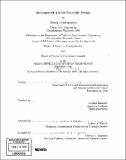| dc.contributor.advisor | Cynthia Barnhart. | en_US |
| dc.contributor.author | Lohatepanont, Manoj, 1974- | en_US |
| dc.date.accessioned | 2005-09-26T19:08:53Z | |
| dc.date.available | 2005-09-26T19:08:53Z | |
| dc.date.copyright | 1998 | en_US |
| dc.date.issued | 1999 | en_US |
| dc.identifier.uri | http://hdl.handle.net/1721.1/28210 | |
| dc.description | Thesis (S.M.)--Massachusetts Institute of Technology, Dept. of Civil and Environmental Engineering; and, (S.M.)--Massachusetts Institute of Technology, Sloan School of Management, Operations Research Center, February 1999. | en_US |
| dc.description | Includes bibliographical references (p. 83-86). | en_US |
| dc.description.abstract | We consider the problem of integrating flight schedule design and fleet assignment decisions at airlines. The flight schedule design problem involves selecting and scheduling the set of flight legs that an airline will include in its service network. Fleet assignment involves assigning a particular aircraft type to each flight leg in the schedule. Due to the particularly challenging nature of schedule design problems, we limit our focus to that of incremental schedule design. Incremental schedule design involves the modification of a given flight schedule to produce an improved schedule by adding, deleting, and rescheduling flight legs. We present models and algorithms to achieve incremental schedule design and unlike previous schedule design efforts, we explicitly model flight demand and supply interactions. We present two case studies, using our models and algorithms. The first case study allows flight additions and deletions, while the second allows flights to be rescheduled. Future case studies well integrate these flight modification options. In our first case study, high-yield flights are maintained in the schedule and low-yield flights are dropped. Although the resulting schedule incurs higher spill costs, the savings from flight operating costs are sufficiently large to offset these higher spill costs, resulting in a more profitable schedule. The second case study, allowing flights to be rescheduled, considers several network sizes including the domestic network of a large U.S. airline. We consider Free Flight, a system allowing reduced flying times due to improved utilization of the national airspace. We find that reductions in flying times of about 10% can lead to dramatic cost savings for the airline, including reductions in the number of aircraft needed to fly the flight schedule. | en_US |
| dc.description.statementofresponsibility | by Manoj Lohatepanont. | en_US |
| dc.format.extent | 86 p. | en_US |
| dc.format.extent | 4243134 bytes | |
| dc.format.extent | 4252769 bytes | |
| dc.format.mimetype | application/pdf | |
| dc.format.mimetype | application/pdf | |
| dc.language.iso | en_US | |
| dc.publisher | Massachusetts Institute of Technology | en_US |
| dc.rights | M.I.T. theses are protected by copyright. They may be viewed from this source for any purpose, but reproduction or distribution in any format is prohibited without written permission. See provided URL for inquiries about permission. | en_US |
| dc.rights.uri | http://dspace.mit.edu/handle/1721.1/7582 | |
| dc.subject | Civil and Environmental Engineering | en_US |
| dc.subject | Sloan School of Management | en_US |
| dc.subject | Operations Research Center | en_US |
| dc.title | Incremental airline schedule design | en_US |
| dc.type | Thesis | en_US |
| dc.description.degree | S.M. | en_US |
| dc.contributor.department | Massachusetts Institute of Technology. Department of Civil and Environmental Engineering | en_US |
| dc.contributor.department | Massachusetts Institute of Technology. Operations Research Center | en_US |
| dc.contributor.department | Sloan School of Management | en_US |
| dc.identifier.oclc | 42677484 | en_US |
